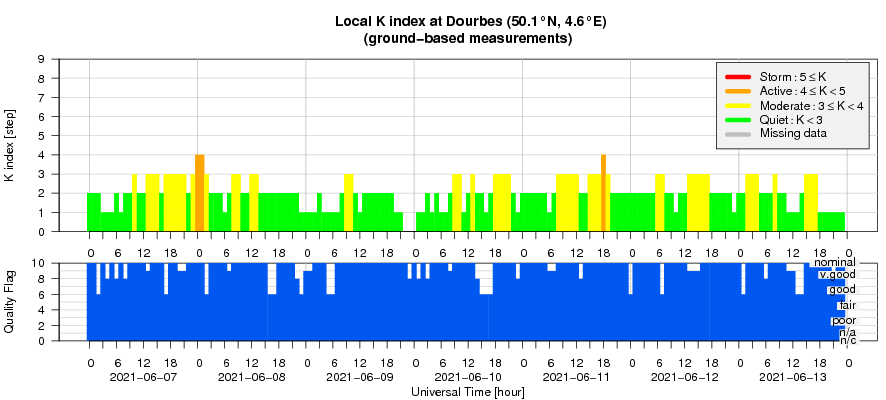- Table of Content
- 1.The best of......
- 2.Small flare, s...
- 3.Review of sola...
- 4.The Internatio...
- 5.PROBA2 Observa...
- 6.Review of geom...
- 7.Geomagnetic Ob...
- 8.The SIDC Space...
- 9.Review of iono...
- 10.STCE in action...
2. Small flare, spectacular eruption!
3. Review of solar activity
4. The International Sunspot Number by Silso
5. PROBA2 Observations (7 Jun 2021 - 13 Jun 2021)
6. Review of geomagnetic activity
7. Geomagnetic Observations at Dourbes (7 Jun 2021 - 13 Jun 2021)
8. The SIDC Space Weather Briefing
9. Review of ionospheric activity (7 Jun 2021 - 13 Jun 2021)
10. STCE in action: upcoming events
The best of... 2020!
A compilation of the most memorable space weather moments of 2020 can be found at the STCE's dedicated Solar Cycle webpage: http://www.stce.be/highlights
Using the versatile Space Weather JHelioviewer (SWHV : http://swhv.oma.be/user_manual/ ) software, a ***MOVIE*** was created containing one or more clips of each event. Mostly SDO-images were used, occasionally supplemented with imagery from PROBA2, SOHO, STEREO and GOES/SUVI.
The movie can be found on YouTube https://www.youtube.com/watch?v=zAbMdm_-QMk and is also downloadable (wmv - 432MB) from https://www.stce.be/movies/Best of 2020.wmv , whereas the page with the accompanying information is at https://www.stce.be/news/535/welcome.html
We wish you a happy viewing!
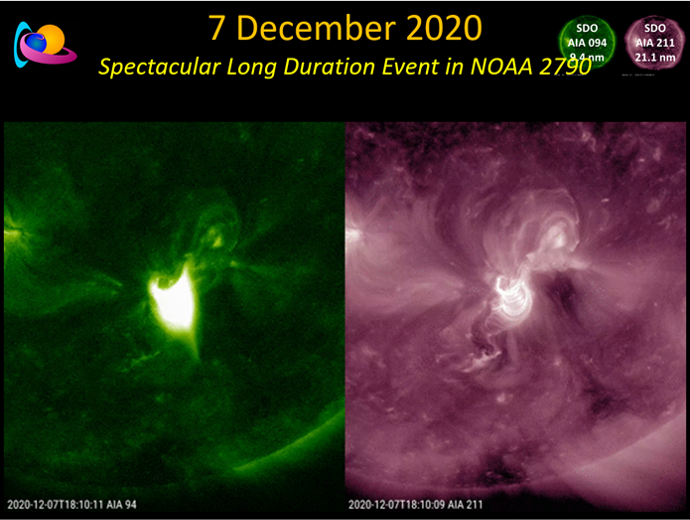
Small flare, spectacular eruption!
A spectacular eruption near the Sun's northwest limb took place shortly before noon on 9 June. The source of the eruption was NOAA2831, which was located beyond the solar limb. This explains also why the eruption was associated with only a C1.7 flare peaking at 11:59UT, as most of the blast site was occulted by the solar disk. The event was also recorded at radio wavelengths, with the Solar Radioastronomy Station in Humain recording a very nice Type II burst, indicative of a coronal mass ejection (CME). Analysis revealed that the shock of this CME had a speed of 1453 km/s (NOAA). The event was also the cause of a small proton enhancement (only for protons with energies of 10 MeV or more), but remained well below the alert threshold. The CME became first visible in the LASCO coronagraphs at 12:24UT, and had a speed near 450 km/s (CACTus). The CME seem to have interacted with the magnetic field from the northern polar coronal hole and got deflected explaining its somewhat messy and atypical structure. See the imagery from SUVI in this STCE Newsitem for a similar event (https://www.stce.be/news/484/welcome.html ).
Underneath an image of the eruption in Extreme Ultraviolet (EUV) by SDO/AIA 304, an image combining PROBA2/SWAP imagery (also in EUV, but at 17.4 nm) with coronagraphic images from SOHO/LASCO C2, and a radiospectrogram by the Humain station showing the Type II radio burst. Clips are in the online version of this article at https://www.stce.be/news/536/welcome.html
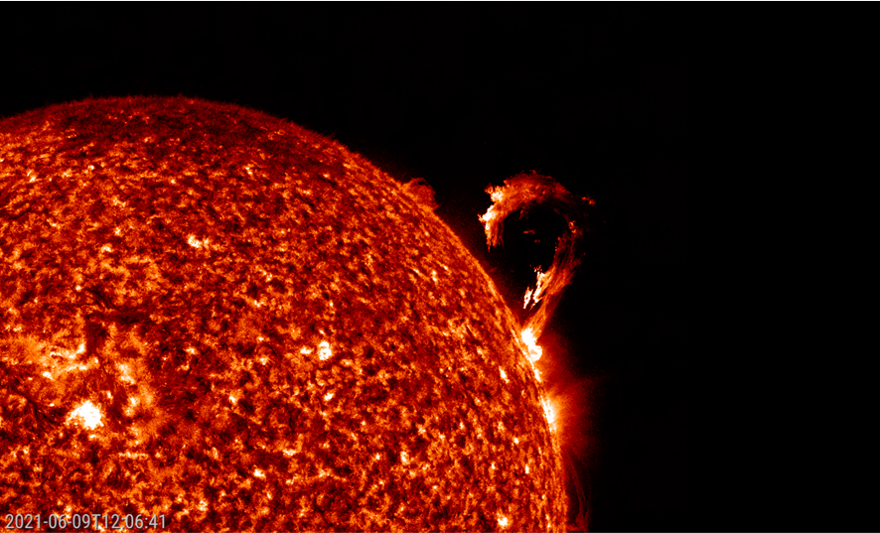
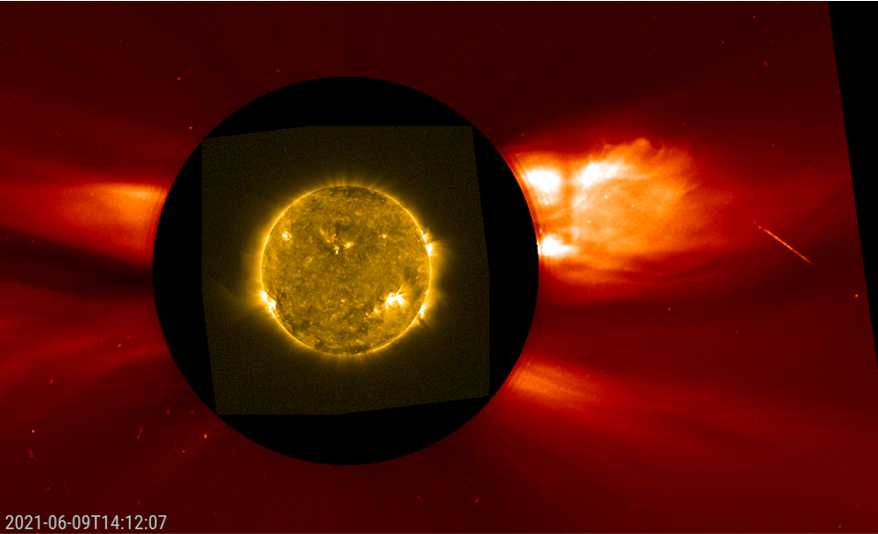
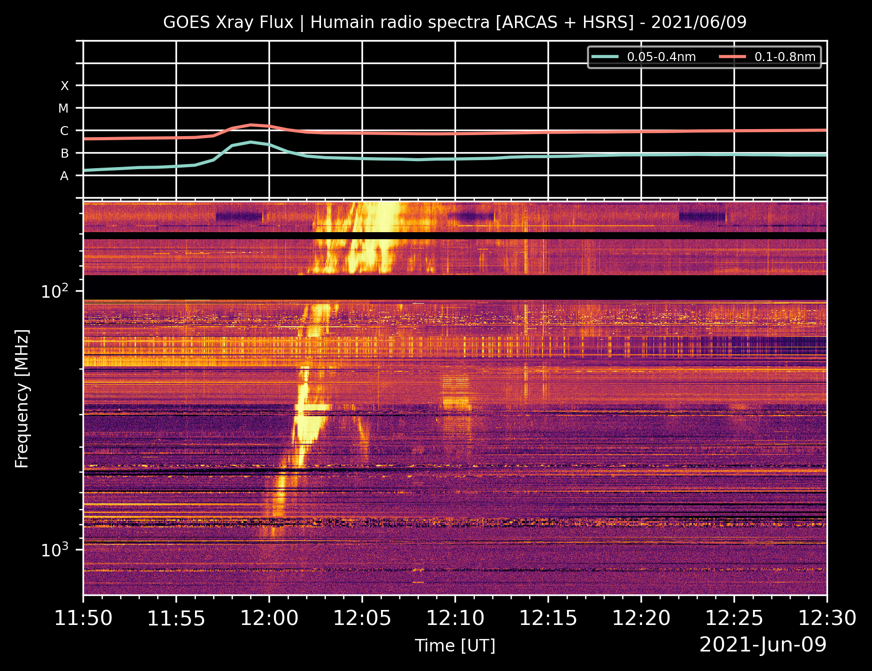
Review of solar activity
During this week seven numbered active regions were observed on the visible side of the Sun: NOAA AR 2827, 2828, 2829, 2830, 2831, 2832 and 28233. The GOES satellite measured 6 C-class flare and numerous B-class flares. The largest reported flare was C3.7 flare observed on June 09 (peak at 09:07 UT) which originated from the NOAA AR 2831, at that moment situated close to and behind the west solar limb. The flare was associated with a CME which was in the field of view of the SOHO/LASCO C2 instrument at 10:12 UT. The CME had angular width of about 100 degrees and a projected line of the sight speed of 600 km/s. Because the source region of this CME was behind the West solar limb the disturbance was not directed towards Earth.
At the end of the previous week, the low latitude extension of the southern polar coronal hole had completely crossed the central meridian. At the beginning of this week, it was still present in the Western solar hemisphere.
A large extension (up to solar equator) of the southern polar coronal hole crossed the central meridian in the early morning of June 12.
The greater than 2MeV electron flux was nearly always below the 1000 pfu threshold.
The 24h electron fluence was the whole week at a nominal level.
The International Sunspot Number by Silso
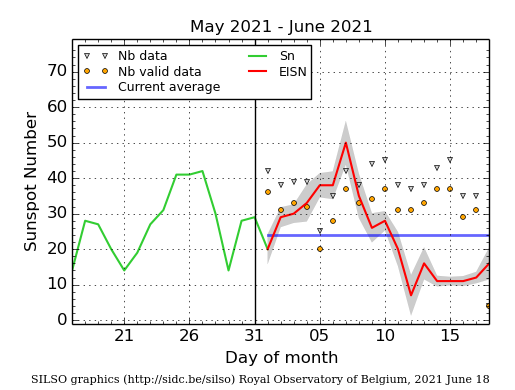
The daily Estimated International Sunspot Number (EISN, red curve with shaded error) derived by a simplified method from real-time data from the worldwide SILSO network. It extends the official Sunspot Number from the full processing of the preceding month (green line), a few days more than one solar rotation. The horizontal blue line shows the current monthly average. The yellow dots gives the number of stations that provided valid data. Valid data are used to calculate the EISN. The triangle gives the number of stations providing data. When a triangle and a yellow dot coincide, it means that all the data is used to calculate the EISN of that day.
PROBA2 Observations (7 Jun 2021 - 13 Jun 2021)
Solar Activity
Solar flare activity fluctuated from very low to low during the week.
In order to view the activity of this week in more detail, we suggest to go to the following website from which all the daily (normal and difference) movies can be accessed: https://proba2.oma.be/ssa
This page also lists the recorded flaring events.
A weekly overview movie can be found here (SWAP week 585). https://proba2.oma.be/swap/data/mpg/movies/weekly_movies/weekly_movie_2021_06_07.mp4
Details about some of this week's events can be found further below.
If any of the linked movies are unavailable they can be found in the P2SC movie repository here https://proba2.oma.be/swap/data/mpg/movies/
Wednesday Jun 09
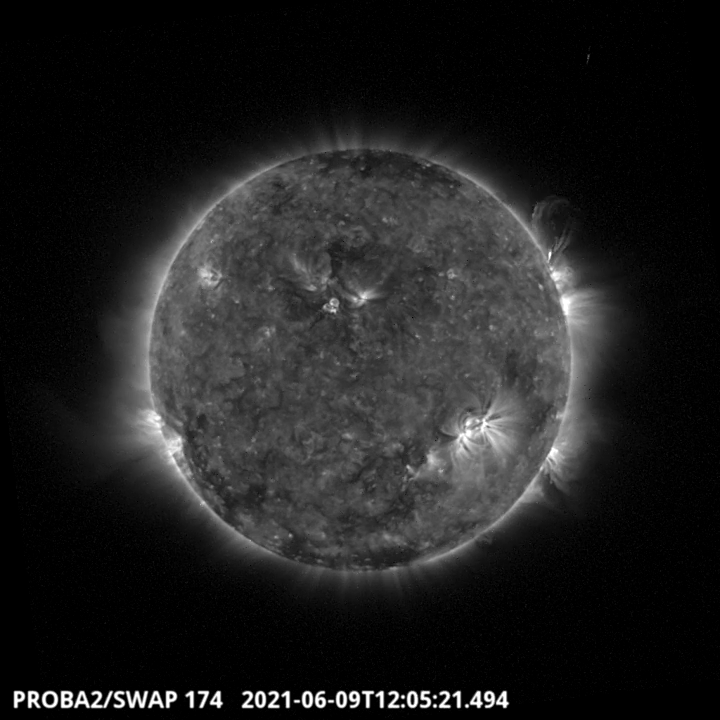
Departing from the NOAA active region 2831 on the North-West part of the solar disk, a plume of plasma erupted and is visible on the SWAP image above around 12:05 UT. Find a movie of the events here (SWAP movie) https://proba2.oma.be/swap/data/mpg/movies/20210609_swap_movie.mp4
Thursday Jun 10
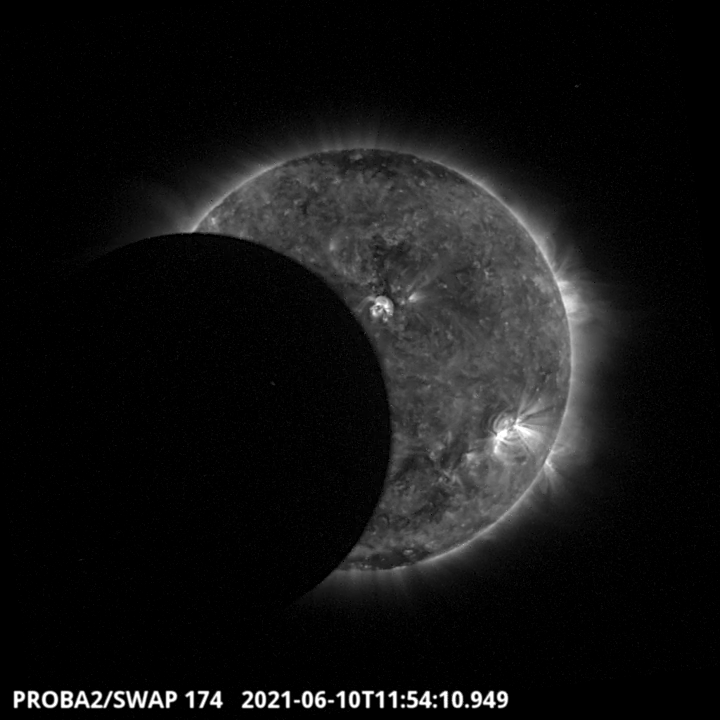
A partial eclipse was observed by SWAP on June 10. The satellite transited three times in the Moon shadow. An eclipse challenge has been organized by the SWAP/LYRA team for the occasion. Find a movie of the events here (SWAP movie) https://proba2.oma.be/swap/data/mpg/movies/20210610_swap_movie.mp4
Review of geomagnetic activity
The solar wind originating from the negative polarity coronal hole (extension of the southern polar coronal hole) arrived in the L1 point in the morning of June 07. First, the interplanetary magnetic field and the solar wind density increased, followed by an increase of the temperature and the speed. The speed went up to 550 km/s, and the interplanetary magnetic field magnitude to 13 nT.
A magnetic structure, possibly an ICME passed L1 on June 11. The interplanetary magnetic field increased rather suddenly to 8 nT to stay elevated for more than 24 hours, and its Bz component turned at the same time negative (- 7 nT) and was negative for several hours. The phi angle changed at the same time. The density, temperature and the speed did not change. The large prominence eruption in the South-East quadrant of the Sun, at about 21:00 UT on June 05 could be the solar source.
The magnetic structure was on June 12 followed by a fast solar wind, possibly originating from the positive polarity coronal hole that was near the central meridian on June 08 and 09. The solar wind speed and its temperature increased simultaneoulsy. The phi angle became positive value. These changes were preceded by an increase and drop of the density.
The geomagnetic conditions were mostly quiet to unsettled with a few isolated active intervals. The solar wind emanating from the southern polar coronal hole induced active geomagnetic conditions (the station at Dourbes reported Kp 4 and NOAA reported K 4) on June 08. The magnetic structure induced active geomagnetic conditions on June 11 and 12 (the station at Dourbes reported Kp 4 and NOAA K 4).
The SIDC Space Weather Briefing
The Space Weather Briefing presented by the forecaster on duty from June 6 to 13. It reflects in images and graphs what is written in the Solar and Geomagnetic Activity report.

A pdf-version: https://www.stce.be/briefings/20210614_SWbriefing.pdf
The movie: https://www.stce.be/briefings/20210614_SWbriefing.m4v
Review of ionospheric activity (7 Jun 2021 - 13 Jun 2021)
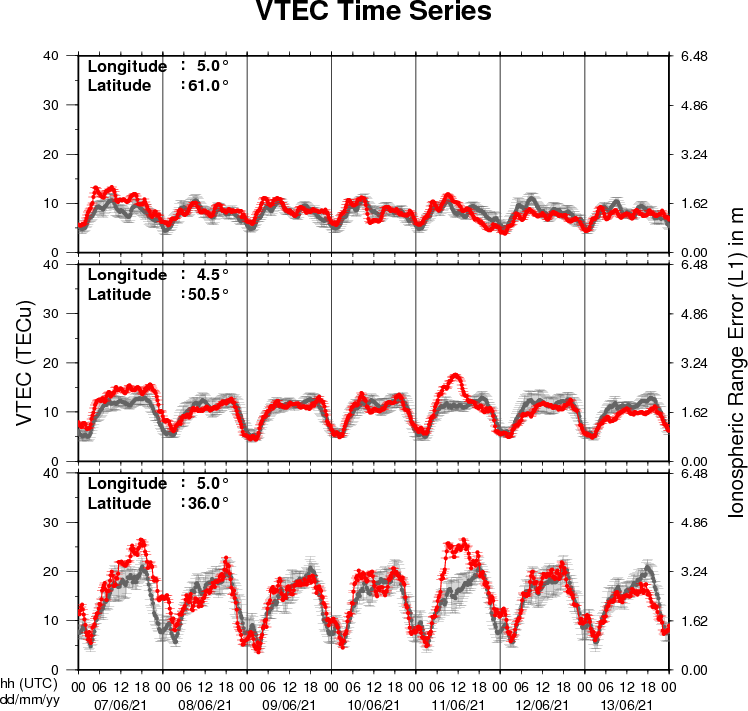
The figure shows the time evolution of the Vertical Total Electron Content (VTEC) (in red) during the last week at three locations:
a) in the northern part of Europe(N61°, 5°E)
b) above Brussels(N50.5°, 4.5°E)
c) in the southern part of Europe(N36°, 5°E)
This figure also shows (in grey) the normal ionospheric behaviour expected based on the median VTEC from the 15 previous days.
The VTEC is expressed in TECu (with TECu=10^16 electrons per square meter) and is directly related to the signal propagation delay due to the ionosphere (in figure: delay on GPS L1 frequency).
The Sun's radiation ionizes the Earth's upper atmosphere, the ionosphere, located from about 60km to 1000km above the Earth's surface.The ionization process in the ionosphere produces ions and free electrons. These electrons perturb the propagation of the GNSS (Global Navigation Satellite System) signals by inducing a so-called ionospheric delay.
See http://stce.be/newsletter/GNSS_final.pdf for some more explanations ; for detailed information, see http://gnss.be/ionosphere_tutorial.php
STCE in action: upcoming events
Check out our activity calendar: activities and encounters with space weather as main theme. We provide occasions to get submerged in the world of space weather through educational, informative and instructive activities.
Due to COVID, these activities and events are organised online.
June 24, 13:30 - seminar: How virtual observatories facilitate good data management - organised by the ROB solar physics department
August 23, 13:00 - Lecture 'De Zon' - organised by VVS
October 11 - 15 - Space Weather Introductory Course, registrations are open
November 22 - 26, Space Weather Introductory Course, registrations are open
Details on https://www.stce.be/calendar

